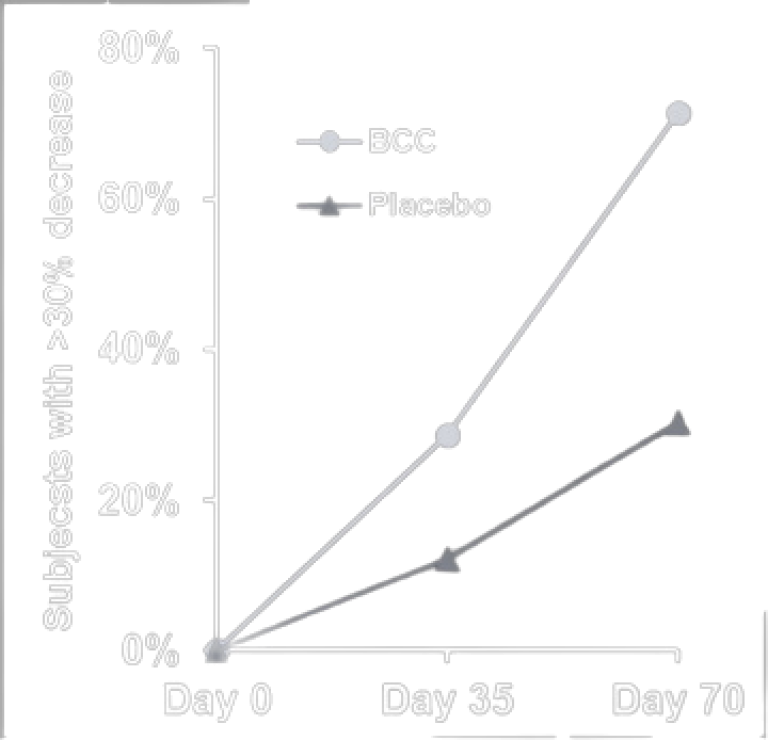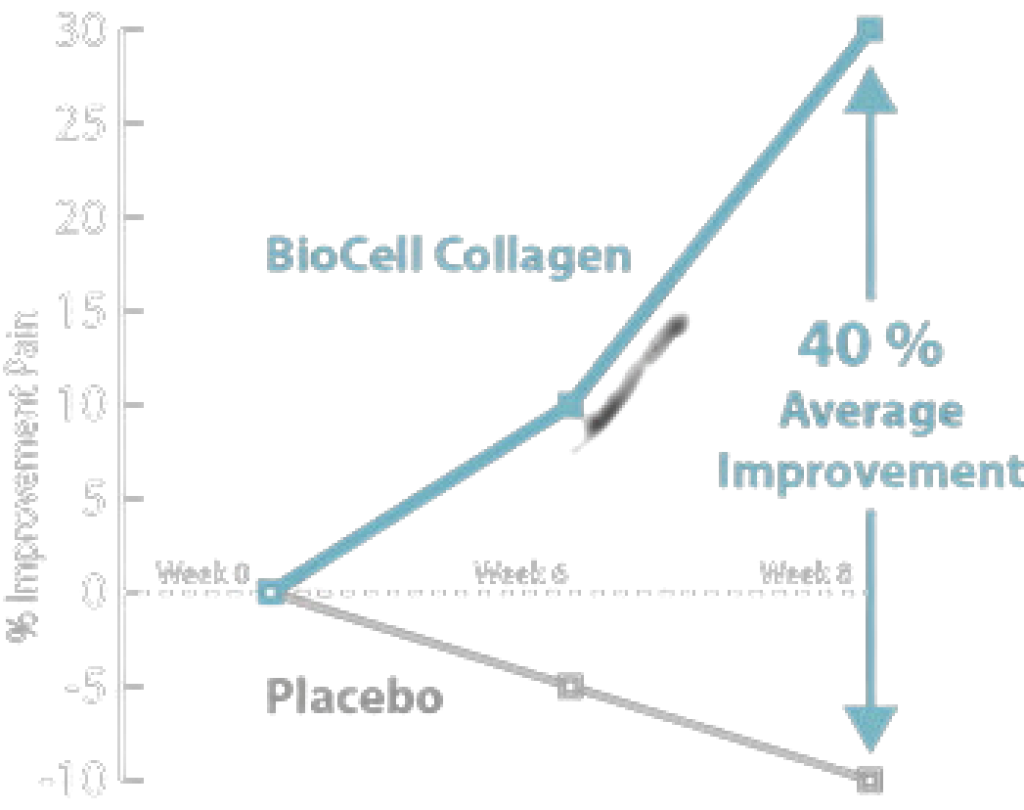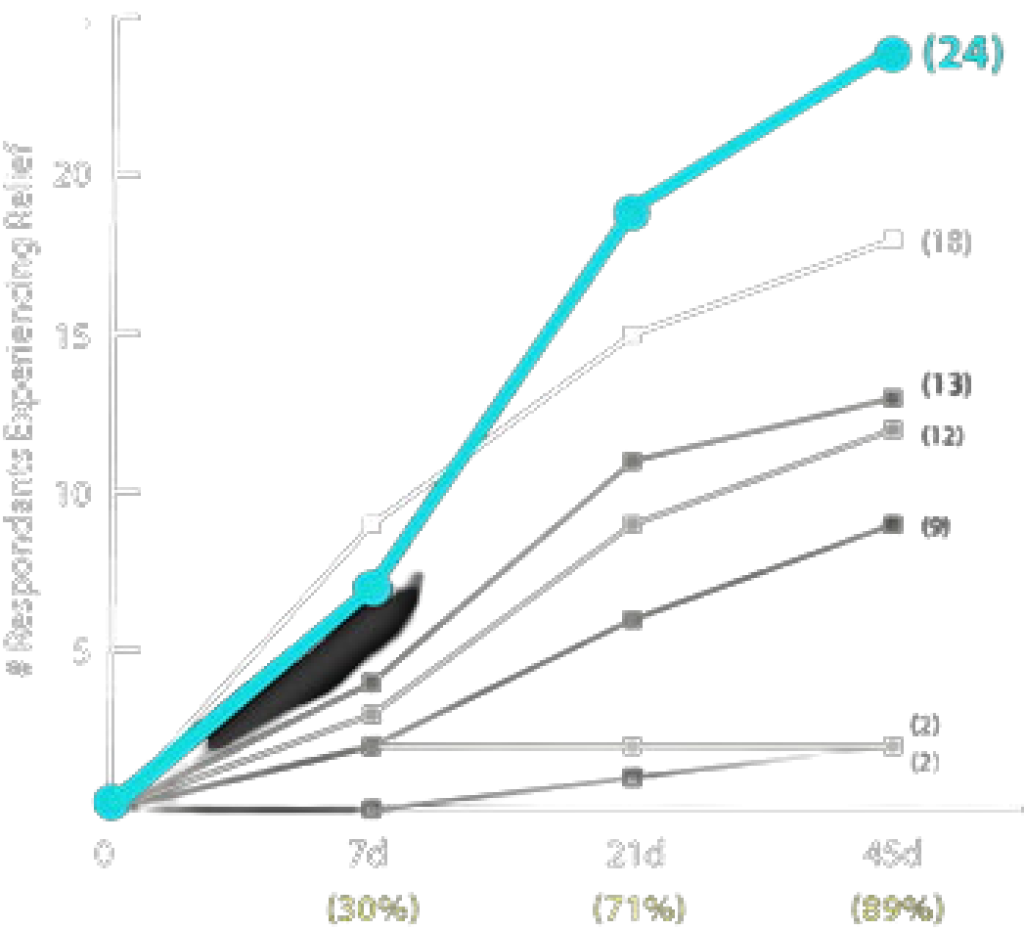Biocell Guide | Biocell Liquid Collagen
SAVE UP TO 15% : Save up to 15% every day, get free shipping, and more!
*Discount applied at checkout
Home » Biocell Collagen » Biocell Collagen Clinical Trials
![]()

1. Effect of BioCell Collagen®, on Improving Joint Comfort: A Randomized, Double-Blind, Placebo-Controlled Trial.
Eighty participants were divided into two groups and given either 2 grams of BioCell Collagen® or a placebo for ten weeks.
On days 35 (p = 0.017) and 70 (p 0.001), the BioCell group saw a significant improvement in joint comfort compared to the placebo group.
On days 35 (p = 0.007) and 70 (p 0.001), the BioCell group showed a significant improvement in physical activities compared to the placebo group.
BioCell Collagen was proven to be well tolerated and effective, enhancing mobility and quality of life.
The study was published in the Journal of Agriculture and Food Chemistry after peer review. (https://pubs.acs.org/doi/10.1021/jf205295u) (Schauss et al., 2012). (Schauss et al., 2012).
71% of those who took BioCell Collagen showed at least a 30% improvement.

2. A Randomized, Double-Blind, Clinical Pilot Study to Evaluate the Safety and Efficacy of BioCell Collagen® for Joint Comfort.
For eight weeks, sixteen individuals, evenly divided into two groups, consumed 1000 mg of BioCell Collagen® twice day (2 g) or a placebo.
Compared with the placebo group, the BioCell group demonstrated 40% more improvement.
BioCell Collagen is not related with any adverse outcomes.
The study details were presented at the 2004 Experimental Biology international conference in Washington, D.C.
The study’s findings – a 40% improvement

3. The consumption of BioCell Collagen® improved blood microcirculation and diminished facial indications of aging.
Twenty-six healthy female participants between the ages of 35 and 59 of varied ethnic backgrounds.
The subjects consumed 1 g of BioCell Collagen® twice daily, in the morning and evening, for 12 weeks.
The following results were exhibited by BioCell Collagen®:
- Significant improvement in the appearance of face lines and wrinkles
- Significant improvement in face skin hydration and scaling
- Increased face dermal collagen concentration and microcirculation
The findings of the study are published in Clinical Interventions in Aging (2012).
(http://www.ncbi.nlm.nih.gov/pubmed/22956862)
BioCell Collagen® Enhances Facial Epidermis and Connective Tissue in Healthy Adult Women: A Randomized, Blinded, Placebo-Controlled Study.
One hundred thirteen healthy female participants between the ages of 39 and 59.
The subjects consumed 1 g of BioCell Collagen® twice daily, in the morning and evening, for 12 weeks.
Compared to a placebo, BioCell Collagen® demonstrated the following results:
Reduced face lines and wrinkles (P =.019) and crow’s feet lines and wrinkles (P =.05) significantly.
Enhanced skin elasticity (P =.008) and cutaneous collagen content (P
Significantly better visual grading and wrinkle width indicators linked with a more youthful skin look (P =.046)
Reduced skin dryness and redness
Alternative Therapies in Health and Medicine publication publishes the study’s results (2019).
(https://www.ncbi.nlm.nih.gov/pubmed/31221944)
4. Ingestion of BioCell Collagen®; enhanced blood microcirculation and reduced facial aging signs.
- Twenty-six healthy female participants between the ages of 35 and 59 of varied ethnic backgrounds.
- The subjects consumed 1 g of BioCell Collagen® twice daily, in the morning and evening, for 12 weeks.
The following results were exhibited by BioCell Collagen®:
- Significant improvement in the appearance of face lines and wrinkles
- Significant improvement in face skin hydration and scaling
- Increased face dermal collagen concentration and microcirculation
The findings of the study are published in Clinical Interventions in Aging (2012).
(http://www.ncbi.nlm.nih.gov/pubmed/22956862)
BioCell Collagen® Enhances Facial Epidermis and Connective Tissue in Healthy Adult Women: A Randomized, Blinded, Placebo-Controlled Study.
One hundred thirteen healthy female participants between the ages of 39 and 59.
The subjects consumed 1 g of BioCell Collagen® twice daily, in the morning and evening, for 12 weeks.
Compared to a placebo, BioCell Collagen® demonstrated the following results:
Reduced face lines and wrinkles (P =.019) and crow’s feet lines and wrinkles (P =.05) significantly.
Enhanced skin elasticity (P =.008) and cutaneous collagen content (P
Significantly better visual grading and wrinkle width indicators linked with a more youthful skin look (P =.046)
Reduced skin dryness and redness
Alternative Therapies in Health and Medicine publication publishes the study’s results (2019).
5. The BioCell Supplement for Subjective Pain (1999)
This prospective, crossover, double-blind clinical trial with 89 participants compared daily supplementation with 2 g of BioCell component to placebo for three months.
Within 45 days of taking the BioCell supplement, eighty-nine percent of the ninety-nine participants who complained of subjective discomfort of varying types reported some degree of relief.
In comparison, only one placebo individual improved.
No bad effects associated with BioCell supplement. (unpublished study from 1999)
Study results – Effective in 89% of subjects

Biocell Collagen Clinical Studies
Summary :
The aim of the study was to find the relationship between Biocell Collagen supplementation with any changes associated with skin aging. To see if Biocell Collagen does in fact reverse the signs of aging by improving skin health as well as joint, teeth, nails and hair.
Method :
A 12-week, randomized, double-blind, placebo-controlled trial of 128 female subjects, aged 39–59 (50.57 ± 5.55) randomly assigned to treatment or placebo. Intervention: Twice daily oral administration of a supplement containing 500 mg of a naturally occurring matrix of collagen type-II peptides, hyaluronic acid, and chondroitin sulfate, derived from chicken sternal cartilage, or placebo. Primary outcome measures: trans-epidermal water loss, viscoelasticity, hydration, collagen content, chromophore (melanin) content and hemoglobin level, and photographic analysis. Expert visual grading for facial lines/wrinkles, crow’s feet lines/wrinkles, skin texture/smoothness, and skin tone. Secondary outcomes: Tolerance and incidence of adverse events. Presence of erythema and/or dryness determined tolerance. Participant’s perception of the product’s value.
Results :
Dietary supplementation significantly reduced facial lines and wrinkles (p = 0.019), crow’s feet lines/wrinkles (p = 0.05), increased skin elasticity (p = 0.05), cutaneous collagen content (p = 0.001), and improved indicators of youthful skin appearance and wrinkle width (p = 0.046), and decreased skin dryness and erythema, compared to placebo.
Dietary supplementation of this chicken sternal cartilage extract supports the accumulation of types-I/III collagen in skin to promote increased elasticity and reduced skin wrinkling in women 39 to 59 years of age.
Work Cited :
Schauss, A. “The Effects of Skin Aging Associated with the Use of BioCell Collagen: A Randomized, Double-blind, Placebo-controlled Clinical Trial”. https://academic.oup.com/cdn/article/3/Supplement_1/nzz031.P06-122-19/5517780?login=true
Summary :
Skin aging and its clinical manifestations are associated with changes in the skins molecular metabolism. In a clinical study, the effects of a dietary supplement called BioCell Collagen was studied. The clinical study involved 26 healthy females with visible signs of natural and photoaging.
Results :
Daily supplementation with 1 g of Biocell Collagen for 12 weeks resulted in a significant decrease in skin dryness/scaling (76 percent, P = 0.002) and global lines/wrinkles (13.2 percent, P = 0.028), as determined by visual/tactile score. Additionally, after 6 weeks of supplementation, a significant increase in hemoglobin (17.7%, P = 0.018) and collagen (6.3 percent, P = 0.002) content was observed in the skin dermis.
Work Cited :
Schwartz, S R. “Ingestion of BioCell Collagen, a novel hydrolyzed chicken sternal cartilage extract; enhanced blood microcirculation and reduced facial aging signs”. https://www.ncbi.nlm.nih.gov/pmc/articles/PMC3426261/
Summary :
Osteoarthritis is a leading cause of pain and disability for the elderly. Medical and surgical treatments available today can be expensive and have serious side effects. So a clinical study was conducted to see if Biocell Collagen supplements could potentially reduce pain in the joints as well as rebuilding cartilage.
The purpose of this randomized, double-blind, placebo-controlled trial was to determine the tolerability and efficacy of BioCell Collagen, a low molecular weight dietary supplement containing hydrolyzed chicken sternal cartilage extract.
The clinical study included 80 patients (n = 80) who had physician-verified evidence of Osteoarthritis in their hip or knee joints. Joint pain had been present for at least three months prior to enrollment, and pain levels were 4 or greater in pain, as measured by Physician Global Assessment scores. For 70 days, subjects were divided into two groups and given either 2 g of Biocell Collagen or a placebo.
Results :
Intention-to-treat analysis revealed that the treatment group significantly reduced joint pain on day 70 (p 0.001) and WOMAC scores on days 35 (p = 0.017) and 70 (p 0.001). On days 35 (p = 0.007) and 70 (p 0.001), the Biocell Collagen group demonstrated a significant improvement in physical activity compared to the placebo group as well as reduced pain levels.
The clinical study found that Biocell Collagen may be considered a possible adjuct therapy to currently available Osteoarthritis therapies.
Work Cited :
Schauss, A G. “Effect of the Novel Low Molecular Weight Hydrolyzed Chicken Sternal Cartilage Extract, BioCell Collagen, on Improving Osteoarthritis-Related Symptoms: A Randomized, Double-Blind, Placebo-Controlled Trial“. https://pubs.acs.org/doi/abs/10.1021/jf205295u
Summary :
Excessive exposure to ultraviolet B Sun radiation accelerates the aging process of the skin (a process known as photoaging). The purpose of this Clinical Study was to determine whether oral administration of Biocell Collagen could alleviate or possibly reverse the effects of photoaging.
Results :
By administering Biocell Collagen, skin water loss, skin inflammation and wrinkles were all significantly reduced. The study also found that Biocell Collagen supplementation protects the skin from UVB-induced photoaging.
Work Cited :
Phipps, K R. “Oral administration of a novel hydrolyzed chicken sternal cartilage extract (BioCell Collagen) reduces UVB-induced photoaging in mice“. https://www.sciencedirect.com/science/article/pii/S1756464620300943
Summary :
The extracellular matrix (ECM) of muscle, tendon, and ligament is sensitive to exercise-induced mechanical stimuli. Exercise-induced muscle damage is associated with not only myofibrillar injury, but also the involvement of connective tissue elements such as collagen, proteoglycans (PG), tendon and ligament. However, little is known about the impact of nutritional agents and metabolic optimization for enhancing adaptation and recovery of the connective tissue elements that support musculoskeletal function. BioCell Collagen (BCC) is a patented hydrolyzed chicken sternal cartilage extract that contains a naturally-occurring matrix of hydrolyzed collagen type II, and low molecular weight glycosaminoglycans such as chondroitin sulfate and hyaluronic acid. The purpose of this pilot study was to determine the potential impact of daily supplementation with Biocell Collagen on functional indices and molecular biomarkers of recovery from intense exercise, and identify effect sizes on various outcome measures.
Methods :
Eight healthy, recreationally active subjects (29.3 ± 9.2 y, 173.1 ± 8.2 cm, 77.3 ± 13.5 kg) volunteered to participate in this study and were randomized in a double-blind, placebo-controlled fashion to ingest either 3 g of placebo or BioCell Collagen daily over a 6-week period prior to an upper body muscle-damaging resistance exercise challenge (UBC) on day 43, and a re-challenge on day 46. At the end of the 6-week supplementation period, participants completed a UBC consisting of 8 sets of barbell bench press at 75% of body weight load to exhaustion with a 4/0/X repetition tempo and 90 seconds rest between sets; the UBC exercise challenge was repeated 72 hours later to assess recovery of function. Consent to publish the results was obtained from all participants.
Results :
The preliminary data from this proof-of-concept study indicate that daily consumption of Biocell Collagen for six weeks may have a beneficial effect on key biochemical markers of connective and skeletal muscle tissue damage and may improve stress resilience following intense resistance exercise.
Supplementation was well tolerated and had no detrimental effect on health-related markers or side effect profiles.
Work Cited :
Lopez, H L. “Effects of BioCell Collagen on connective tissue protection and functional recovery from exercise in healthy adults: a pilot study”. https://link.springer.com/article/10.1186/1550-2783-11-S1-P48
Summary :
Dietary consumption of food supplements has been found to modulate skin functions and can therefore be useful in the treatment of skin aging.
Methods :
In this double-blind, placebo-controlled study, the effectiveness of the specific bioactive collagen peptide (BCP) VERISOL® on eye wrinkle formation and stimulation of procollagen I, elastin and fibrillin biosynthesis in the skin was assessed. A hundred and fourteen women aged 45-65 years were randomized to receive 2.5 g of BCP or placebo, once daily for 8 weeks, with 57 subjects being allocated to each treatment group. Skin wrinkles were objectively measured in all subjects, before starting the treatment, after 4 and 8 weeks as well as 4 weeks after the last intake (4-week regression phase). A subgroup was established for suction blister biopsies analyzing procollagen I, elastin and fibrillin at the beginning of the treatment and after 8 weeks of intake.
Results :
The ingestion of the specific Biocell Collagen used in this study promoted a statistically significant reduction in the amount of eye wrinkles and fine lines (p < 0.05), in comparison to the placebo group after 4 and 8 weeks (20%) of intake. Moreover a positive long-lasting effect was observed 4 weeks after the last Biocell Collagen administration (p < 0.05).
Additionally, after 8 weeks of intake a statistically significantly higher content of procollagen type I (65%) and elastin (18%) in the Biocell Collagen-treated volunteers compared to the placebo-treated patients was detected.
Work Cited :
Proksch E. “Oral Intake of Specific Bioactive Collagen Peptides Reduces Skin Wrinkles and Increases Dermal Matrix Synthesis”. https://www.karger.com/Article/Abstract/355523
Summary :
The aim of the study intended to correlate the effects of the dietary supplement, BioCell Collagen, with any changes associated with skin aging, since dietary supplements claim cutaneous anti-aging properties for their products; however, research supporting these claims remains sparse.
Methods :
A 12-week, randomized, double-blind, placebo-controlled trial of 128 female subjects, aged 39–59 (50.57 ± 5.55) randomly assigned to treatment or placebo. Intervention: Twice daily oral administration of a supplement containing 500 mg of a naturally occurring matrix of collagen type-II peptides, hyaluronic acid, and chondroitin sulfate, derived from chicken sternal cartilage, or placebo. Primary outcome measures: trans-epidermal water loss, viscoelasticity, hydration, collagen content, chromophore (melanin) content and hemoglobin level, and photographic analysis. Expert visual grading for facial lines/wrinkles, crow’s feet lines/wrinkles, skin texture/smoothness, and skin tone. Secondary outcomes: Tolerance and incidence of adverse events. Presence of erythema and/or dryness determined tolerance. Participant’s perception of the product’s value.
Results :
Dietary supplementation significantly reduced facial lines and wrinkles (p = 0.019), crow’s feet lines/wrinkles (p = 0.05), increased skin elasticity (p = 0.05), cutaneous collagen content (p = 0.001), and improved indicators of youthful skin appearance and wrinkle width (p = 0.046), and decreased skin dryness and erythema, compared to placebo. There was no difference between supplement and placebo for skin surface water content or retention. Supplement was well tolerated with no reported adverse reactions.
Dietary supplementation of this chicken sternal cartilage extract supports the accumulation of types-I/III collagen in skin to promote increased elasticity and reduced skin wrinkling in women 39 to 59 years of age.
Work Cited :
Schauss, A. “The Effects of Skin Aging Associated with the Use of BioCell Collagen: A Randomized, Double-blind, Placebo-controlled Clinical Trial.” https://academic.oup.com/cdn/article/3/Supplement_1/nzz031.P06-122-19/5517780
Summary :
Collagen peptides (CPs) have demonstrated to exert beneficial effects on skin photoaging. However, little has been done to evaluate their effects on chronologically aged skin. Here, the effects of CPs from bovine bone on skin aging were investigated in chronologically aged mice.
Methods :
13-month-old female Kunming mice were administered with CPs from bovine bone (200, 400 and 800 mg/kg body weight/day) or proline (400 mg/kg body weight/day) for 8 weeks. Mice body weight, spleen index (SI) and thymus index (TI), degree of skin laxity (DSL), skin components, skin histology and antioxidant indicators were analyzed.
Results :
Ingestion of CPs or proline had no effect on mice skin moisture and hyaluronic acid content, but it significantly improved the skin laxity, repaired collagen fibers, increased collagen content and normalized the ratio of type I to type III collagen in chronologically aged skin. CPs prepared by Alcalase performed better than CPs prepared by collagenase. Furthermore, CPs intake also significantly improved the antioxidative enzyme activities in skin. These results indicate that oral administration of CPs from bovine bone or proline can improve the laxity of chronologically aged skin by changing skin collagen quantitatively and qualitatively, and highlight their potential application as functional foods to combat skin aging in chronologically aged process.
Work Cited :
Song, H D. “Effect of Orally Administered Collagen Peptides from Bovine Bone on Skin Aging in Chronologically Aged Mice.” https://www.mdpi.com/2072-6643/9/11/1209/htm
Summary :
Collagen is protein molecules made up of amino acids. It provides structural support to the extracellular space of connective tissues. Due to its rigidity and resistance to stretching, it is the perfect matrix for skin, tendons, bones, and ligaments.
Collagen can be further divided into several groups depending on the type of structures they form. There are 28 various types of collagen that have been discovered, but by far, the most common are types I through IV, with type I comprising over 90% of the collagen in the human body.[1][2][3]
Results :
Amino acids are the building blocks of proteins; therefore, it is no surprise that collagen is comprised of amino [4]acids. The primary amino acid sequence of collagen is glycine-proline-X or glycine-X-hydroxyproline [5]
X can be any of the other 17 amino acids, and every third amino acid is glycine.
Collagen is composed of 3 chains. The chains are wound together to form a triple helix. Since glycine is the smallest of all the amino acids, it allows the chain to form a tight configuration, and and it can withstand stress.
The process of collagen synthesis occurs mainly in the cells of fibroblasts which are specialized cells with the main function of synthesizing collagen and stroma. Collagen synthesis occurs both intracellularly and extracellularly. Although different types of collagen may undergo different post-translational modifications, the basic outline for collagen synthesis is listed below.
Work Cited :
Marlyn, W. “Biochemistry, Collagen Synthesis.” https://www.ncbi.nlm.nih.gov/books/NBK507709/
Summary :
Collagen peptides (CPs) have demonstrated to exert beneficial effects on skin photoaging. However, little has been done to evaluate their effects on chronologically aged skin.
The impact of aging on the appearance and function of skin has received increasing attention in recent decades. It is widely accepted that skin aging is distinguished into chronological skin aging and skin photoaging [1]. Skin photoaging is caused by solar radiation and it is common in sunlight-exposed skin, especially in the face [2]. Therefore, skin photoaging could be prevented or decreased by photo-protection. The common clinical signs of photoaged skin include deep and coarse wrinkles, dryness, sallowness and laxity [2,3]. In contrast, chronological skin aging is caused by passage of time and it takes place all the time in whole-body skin, including facial skin. Chronologically aged skin is characterized by fine wrinkling and laxity [3]. Chronological skin aging accounts for a great part of skin aging and it is more common than skin photoaging in dark skinned individuals and females [2]. A youthful appearance is considered to play an important role in keeping self-esteem and social relations [4]. Therefore, there is increasing demand for anti-aging interventions to delay or even reverse signs of skin aging.
Methods :
The effects of CPs from bovine bone on skin aging were investigated in chronologically aged mice. 13-month-old female Kunming mice were administered with CPs from bovine bone (200, 400 and 800 mg/kg body weight/day) or proline (400 mg/kg body weight/day) for 8 weeks. Mice body weight, spleen index (SI) and thymus index (TI), degree of skin laxity (DSL), skin components, skin histology and antioxidant indicators were analyzed.
Results :
Ingestion of CPs or proline had no effect on mice skin moisture and hyaluronic acid content, but it significantly improved the skin laxity, repaired collagen fibers, increased collagen content and normalized the ratio of type I to type III collagen in chronologically aged skin. CPs prepared by Alcalase performed better than CPs prepared by collagenase. Furthermore, CPs intake also significantly improved the antioxidative enzyme activities in skin. These results indicate that oral administration of CPs from bovine bone or proline can improve the laxity of chronologically aged skin by changing skin collagen quantitatively and qualitatively, and highlight their potential application as functional foods to combat skin aging in chronologically aged process.
Song, H D. “Effect of Orally Administered Collagen Peptides from Bovine Bone on Skin Aging in Chronologically Aged Mice”. https://www.mdpi.com/2072-6643/9/11/1209/htm
Summary :
Collagen peptides (CPs) have demonstrated to exert beneficial effects on skin photoaging. However, little has been done to evaluate their effects on chronologically aged skin.
The impact of aging on the appearance and function of skin has received increasing attention in recent decades. It is widely accepted that skin aging is distinguished into chronological skin aging and skin photoaging [1]. Skin photoaging is caused by solar radiation and it is common in sunlight-exposed skin, especially in the face [2]. Therefore, skin photoaging could be prevented or decreased by photo-protection. The common clinical signs of photoaged skin include deep and coarse wrinkles, dryness, sallowness and laxity [2,3]. In contrast, chronological skin aging is caused by passage of time and it takes place all the time in whole-body skin, including facial skin. Chronologically aged skin is characterized by fine wrinkling and laxity [3]. Chronological skin aging accounts for a great part of skin aging and it is more common than skin photoaging in dark skinned individuals and females [2]. A youthful appearance is considered to play an important role in keeping self-esteem and social relations [4]. Therefore, there is increasing demand for anti-aging interventions to delay or even reverse signs of skin aging.
Methods :
The effects of CPs from bovine bone on skin aging were investigated in chronologically aged mice. 13-month-old female Kunming mice were administered with CPs from bovine bone (200, 400 and 800 mg/kg body weight/day) or proline (400 mg/kg body weight/day) for 8 weeks. Mice body weight, spleen index (SI) and thymus index (TI), degree of skin laxity (DSL), skin components, skin histology and antioxidant indicators were analyzed.
Results :
Ingestion of CPs or proline had no effect on mice skin moisture and hyaluronic acid content, but it significantly improved the skin laxity, repaired collagen fibers, increased collagen content and normalized the ratio of type I to type III collagen in chronologically aged skin. CPs prepared by Alcalase performed better than CPs prepared by collagenase. Furthermore, CPs intake also significantly improved the antioxidative enzyme activities in skin. These results indicate that oral administration of CPs from bovine bone or proline can improve the laxity of chronologically aged skin by changing skin collagen quantitatively and qualitatively, and highlight their potential application as functional foods to combat skin aging in chronologically aged process.
Work Cited:
Jung, H. “Hyaluronidase: An overview of its properties, applications, and side effects”. https://www.ncbi.nlm.nih.gov/pmc/articles/PMC7398804/
Summary :
The study aimed to determine the potential effect of supplementation with a novel, hydrolyzed chicken sternal cartilage extract—called BioCell Collagen—on biomarkers and functional indices of recovery from intense exercise.
Methods :
The research team designed a randomized, double-blind, placebo-controlled pilot study. A total of 8 individuals, 6 males and 2 females, were enrolled in the study. Participants were 18 to 55 years old, healthy, and recreationally active but not highly trained. It should be noted that participants in the 2 groups were of similar fitness status and levels of physical activity per the Yale Physical Activity Score. All the participants completed the study per protocol.
Results :
The study’s preliminary data are promising with respect to the beneficial effects of the extract on connective tissue protection and recovery in those engaged in routine resistance training and cardiovascular exercise. A larger study is warranted to confirm and refine these findings.
The extract attenuated the post-UBC increase in serum markers for muscle tissue damage: CK, LDH, and CRP. For the intervention group vs the placebo group, the mean changes were as follows: (1) an increase in CK of 20 U/L vs 4726 U/L, respectively; (2) a decrease in LDH of 3.5 U/L vs an increase of 82.9 U/L, respectively; and (3) an increase in CRP of 0.07 mg/L vs an increase of 0.7 mg/L, respectively. The performance decrement in bench press repetitions to failure was 57.9% on day 43 and 57.8% on day 46 for the intervention group vs 72.2% on day 43 and 65% on day 46 for the placebo group. The overall trend for the performance decrement, together with the results for the PRS, suggested that a more robust muscular recovery and adaptive response occurred with use of the extract. The supplement was well tolerated.
Work Cited :
Lopez, H L. “Evaluation of the Effects of BioCell Collagen, a Novel Cartilage Extract, on Connective Tissue Support and Functional Recovery From Exercise”. https://www.ncbi.nlm.nih.gov/pmc/articles/PMC4566464/
Summary :
In this review, we provide a report on recent studies in the field of research on the blends of hyaluronic acid with other natural polymers, namely collagen and chitosan. Hyaluronic acid has attracted significant interest in biomedical and cosmetic applications due to its interesting properties. In recent years, blends of hyaluronic acid with other polymers have been studied for new materials development.
Hyaluronic acid can be used for modification of collagen properties. Collagen is a structural protein that provides fundamental structural and mechanical support in human and animal bodies. Collagen-based materials are widely applied in the biomedical field, for example, it can be used in tissue regeneration/engineering and for new materials fabrication. The example of collagen application is a preparation of artificial skin, bone graft substitutes (collagen composites with inorganic particles), dental implants, artificial tendons and blood vessels, corneal implants, regeneration of nerves, cartilage, and several other tissues [21].
The investigation of the properties of the blends based on collagen and hyaluronic acid has been already initiated and several interesting biomaterials based on such blends have been proposed [22,23,24,25,26,27,28,29,30,31,32,33,34,35,36,37,38,39,40,41]. Several research groups have studied interactions between collagen and HA and the possibility of new materials formation based on such a blend. The possible interactions between collagen and hyaluronic acid are shown in Figure 2.
Results :
Hyaluronic acid is widely studied for its use in biomedical fields. This biopolymer can be modified in several ways, especially blending it with another biopolymer may lead to new interesting biomaterials. The preparation of a hyaluronic acid blend with other polymers and/or biopolymers is neither a closed nor a completed topic, as there are many polymers and biopolymers that can be studied as a component of such the blends. In regenerative medicine, there is still an increasing need for new materials for cell-based transplantation, tissue engineering, drug delivery, and gene therapy. There is also a need to design new wound dressing materials and hydrogels for cosmetic applications. New materials based on the blends of hyaluronic acid with collagen, chitosan as well as with other biopolymers may fulfil the gap between the demand for biomaterials for tissue regeneration and the supply. The potential of newly designed materials using biopolymer blends may be huge; nevertheless, the detailed biological study of any kind of such materials is required.
Work Cited :
Sionkowska, A. “Hyaluronic Acid as a Component of Natural Polymer Blends for Biomedical Applications: A Review.” https://www.ncbi.nlm.nih.gov/pmc/articles/PMC7570474/

